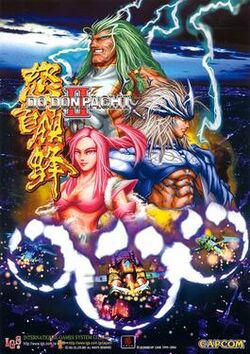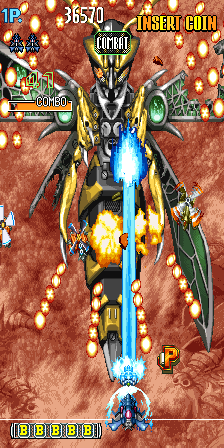Software:DoDonPachi II
| DoDonPachi II | |
|---|---|
 Japanese arcade flyer | |
| Developer(s) | IGS[1] |
| Publisher(s) | |
| Series | DonPachi |
| Platform(s) | Arcade |
| Release | |
| Genre(s) | Vertical scrolling shooter, Bullet hell |
| Mode(s) | Single player, 2 player Co-op |
| Arcade system | PolyGame Master |
DoDonPachi II: Bee Storm (Japanese: 怒首領蜂II DoDonPachi Tsū; Chinese: 蜂暴 Bee Storm) is a vertically scrolling bullet hell shoot 'em up developed by International Games System (IGS) and published by Capcom in 2001.
Gameplay
Upon starting the game, players are greeted with 3 game modes; Practice, Combat, and Internet Rank. Combat takes the player through all 6 stages, facing a boss at the end. Practice mode shortens the experience to 4 stages, and Internet Rank is identical to Combat Mode in terms of game length. However, upon the game ending, you will be given a code you can enter on the official IGS website, where you will be able to view high scores achieved by you and other players.
There are 3 different ship types you can choose from; a narrow shot with fast movement, a wide shot with slow movement, and a shot that moves alongside the ship with medium movement. Upon selecting a ship, you will be given the choice of playing with Bombs or an Energy Meter. Bomb Style will give you 5 bombs with every life, which you can activate by pushing the B button. This amount can be replenished with bomb items that can be obtained by destroying enemies in stages. Energy Style plays differently from Bomb Style; By grazing bullets fired at enemies, the player builds up a meter located at the bottom of the screen. When the meter is filled up, the player can push the B button to fire a super powerful laser, cancelling bullets and rapidly increasing the combo gauge. After activating the laser, the gauge would empty, and it would have to be filled up again. In energy mode, bomb items can be picked up for 20,000 points.
The combo system as seen in Donpachi and Dodonpachi returns in Beestorm, but it is changed from those games. Instead of the combo resetting if enough time passes without defeating enemies, the combo rapidly decreases until it reaches zero. In addition, firing the laser close to large enemies and bosses would rapidly increase the combo meter. Combos can be built up by defeating enemies with shot or laser attacks, or by attacking large enemies with the laser.
In addition to 6 stages and bosses, a secret stage containing the true final boss can be accessed if the player obtains 400 million points, with no second loop. Bombs, deaths, and bee medals do not contribute to finding the boss. Bee medals that would normally contribute to game completion give a fixed value of 20,000 points.
Unlike other games in the Dodonpachi series, plot details are very vague and do not connect to any games before or after it.
Development
Dodonpachi II, despite the name, was not developed by Cave. Instead, it was developed by Taiwan-based IGS (or International Games System). IGS obtained the license to the Dodonpachi name for a new game to release on IGS' new Poly Game Master hardware. The game was first sold in Asian territories like China and Korea before being bought over to Japan.[2]
Around this time, Cave was considering leaving the arcade business due to their decline in popularity and difficulties finding publishers for their work (Progear no Arashi would have been their final game). However, the success of Dodonpachi II convinced Cave to continue their arcade game business, developing Dodonpachi Daioujou a year later.[2]
DoDonPachi II supports Japanese, Chinese, English and Korean. The interface language depends on the protection chip inside the game cartridge, which provides region information. In addition, the game's title, stage names and boss names are also altered depending on the region.[citation needed]
Music
A soundtrack for the first 2 DoDonPachi games was released by Scitron Digital Content.
Reception
In Japan, Game Machine listed DoDonPachi II on their August 1, 2001 issue as being the eighth most-successful arcade game at the time.[3] Time Extension called the game "a hit, convincing CAVE to both stay in the market and to adopt IGS’s PGM hardware for their future titles."[1]
Time Extension said the game apes "the bullet hell style with enjoyable but somewhat crude results" and "[...] the story of how it came to be and how it affected CAVE’s future is the most compelling aspect of its history".[1]
References
- ↑ 1.0 1.1 1.2 Massey, Tom (23 February 2023). "CAVE Story: The Chronicles of DonPachi, The Shmup Series That Changed Everything". Hookshot Media. https://www.timeextension.com/features/cave-story-the-chronicles-of-donpachi-the-shmup-series-that-changed-everything.
- ↑ 2.0 2.1 "Interview: Cave's Tsuneki Ikeda (IKD) from 2010 | Gaming.moe" (in en-US). 2015-03-01. http://gaming.moe/?p=757.
- ↑ "Game Machine's Best Hit Games 25 - TVゲーム機ーソフトウェア (Video Game Software)". Game Machine (Amusement Press, Inc.) (639): 21. 1 August 2001.
External links
- DoDonPachi II at Arcade History
- DonDonPachi II at STG Wiki (in Japanese)
 |


